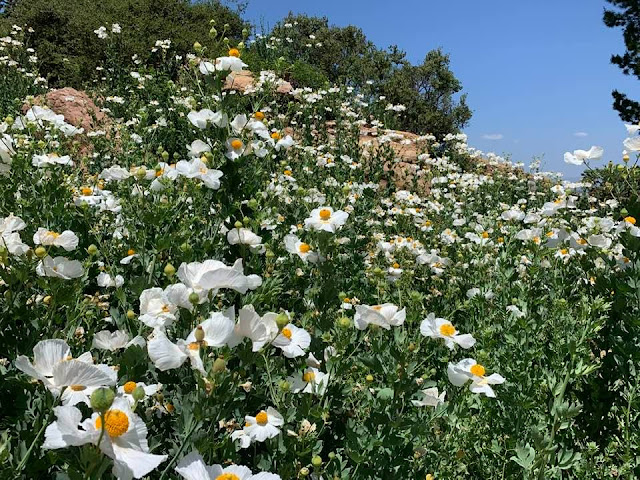California native plants often surprise me. Eriogonum grande var. rubescens looks so delicate and cute, but it is is a solid performer in the garden. It is far from delicate. I remember when I first saw it and thought, "what a flimsy little plant", and I wondered how many plants would it take to form a nice display? It didn't seem possible that a plant with such a dainty flower could ever amount to much. I was wrong.
Sunday, May 24, 2020
Friday, May 22, 2020
Romneya x 'White Cloud'
Amazing photograph of Romneya coulteri by Aaron Landworth |
| Romneya x 'White Cloud' flower S. Reeve |
Romneya coulteri may be the most iconic native California flower. Indeed, author of the book, The Wild Flowers of California, 1897, Mary Elizabeth Parsons, deemed it the, "Queen of California Flowers." I remember the first time I saw it, it was planted en masse along the side of the road in a hot and dry location. I started hyperventilating at the sheer spectacle of so many mammoth luminous crepey-petalled white flowers with a large boss of bright orange-yellow stamens. The easy access to so much pollen had sent the honey bees into a frenzy and flowers had a crowd of honeybees in each one. Ever since then I have wanted to grow this plant. The memory of it caused me to make it one of the first plants I put in the ground at my home in La Mesa, CA. Nothing teaches you more about a plant then growing it and I have learned so much since then. When it is blooming it is easy to see why it is called the, "fried egg" plant. It is also referred to as the Matilija Poppy as it is native to Matilija Canyon in the Ojai Valley and named after Chief Matilija of the Chumash tribe. Although well known by the native Indians, this plant was collected by Irish botanist Dr. Thomas Coulter in 1833, and the genus name came from his friend, astronomer, Dr. Thomas Romney Robinson.
There are two species in the Genus, Romneya coulteri and Romneya trichocalyx. These are Southern California natives with the range of Romneya trichocalyx extending into Baja, CA. Romneya trichocalyx is commonly called, "Hairy Matilija Poppy." It differs from Romneya coulteri in that it can be found at higher elevations, blooms for a shorter period of time, has smooth light brown seeds, and bristles on the sepals and stems. It is also smaller in stature and the leaves tend to be finer and narrower. Romneya coulteri has furry seed pods but has no prickles on the stems or leaves.
Romneya coulteri reaches 8 feet or taller in my garden and the plant spreads widely and invasively by runners. These suckers or traveling roots are impressive in their size and scale. They are golden yellow and up to a half-inch in diameter, and they can vigorously travel for many feet before they pop up again. As boisterous as the roots are, you would think they would transplant easily, but this plant is particularly sensitive to having its roots disturbed. I have tried a number of times to share this plant with others, and even with the most healthy and sizeable rooted sections, it fails.
Flowers of Romneya coulteri are up to 7-or more inches across and are said to be the largest flower of any native California plant. The buds are round and hold so much promise of gigantic flowers to come. The flower has 5-6 large crinkled white petals and is fragrant.
Romney x 'White Cloud' S. Reeve
Subscribe to:
Comments (Atom)














